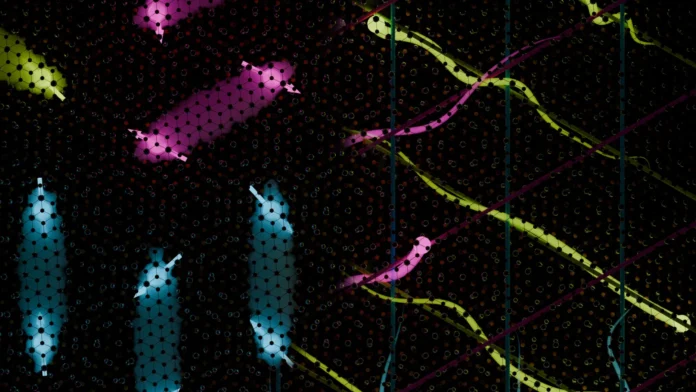Contents
Revolutionizing Physics: Moiré Structures Unlock New Phases of Matter
Physicists have made a groundbreaking discovery in the field of moiré structures, creating entirely new phases of matter through simple geometric manipulation. By twisting two atomically thin sheets of materials, researchers can engineer new quantum states, opening doors to previously unexplored areas of experimental science. This breakthrough promises a future rich in fundamental science and technological applications, from quantum simulators to ultrasensitive terahertz sensors and single-photon detectors.
The discovery of moiré structures has sent shockwaves through the physics community, as scientists have found a way to create new phases of matter by manipulating the twist angle of two atomically thin sheets of materials. This simple yet powerful technique has enabled researchers to unlock new quantum states, which were previously inaccessible. The term “moiré” refers to the strange rippling patterns that appear when photographing striped shirts or screens, but in physics, the same principle applies at the atomic scale. By carefully controlling the twist angle, physicists can engineer new quantum states, allowing for the creation of exotic materials with unique properties.
Understanding Moiré Structures
Moiré structures are created by taking two atomically thin sheets of either the same or different materials and stacking them together. When the layers are twisted, electrons from each layer interfere strongly, reshaping their combined quantum landscape. A striking example of this effect is twisted bilayer graphene, where superconductivity emerges, even though graphene layers individually cannot become superconducting. The electrons in materials have a quantum number called momentum, which describes their quantum mechanical state of motion. Until now, the focus has been on hexagonal lattices twisted around the K-points, but new research has introduced an entirely new twisting paradigm based on the M-point of the electron momentum.
Expanding the Moiré Landscape
A team of international researchers has published a paper in Nature, introducing a new twisting paradigm based on the M-point of the electron momentum. This significant expansion of the moiré landscape unlocks a completely new class of twisted quantum materials with entirely new quantum behavior. According to Dumitru Călugăru, a Leverhulme-Peierls fellow at the University of Oxford, “By shifting our focus to the M points, we unlock a completely new class of twisted quantum materials with entirely new quantum behavior. The position of the electronic band minimum is key.” The research team has identified hundreds of candidate materials suitable for this novel type of twisting and has systematically classified them based on the position of their electronic band minimum.
Some key highlights of the research include:
* The discovery of a new twisting paradigm based on the M-point of the electron momentum
* The identification of hundreds of candidate materials suitable for this novel type of twisting
* The systematic classification of materials based on the position of their electronic band minimum
* The prediction of novel quantum phenomena, including quantum spin liquids and unidirectional spin liquids
* The experimental realization of the proposed materials, including the synthesis of bulk crystals and the exfoliation of single-layer sheets
Quantum Spin Liquids and Beyond
The research team has made significant progress in understanding the properties of M-point twisted materials. Through extensive microscopic ab initio calculations, they have demonstrated that the electron bands become significantly flattened at low twist angles, effectively slowing down electrons and enhancing their mutual interactions. This flattening can localize electrons in either a hexagonal lattice or a kagome lattice arrangement, allowing for the experimental realization of diverse quantum states. According to Haoyu Hu, a postdoctoral researcher at Princeton, “The bands at the M-point possess a previously unnoticed type of symmetry, rendering them highly unusual and sometimes even one-dimensional. This fundamentally alters their quantum behavior.”
Experimental Realization
The experimental realization of the proposed materials is critical to the success of this research. Collaborators in quantum materials chemistry have successfully synthesized bulk crystals of several predicted candidate materials, providing the critical first step toward practical realization. World-leading experts in 2D materials are exfoliating these bulk crystals into single-layer sheets, demonstrating the experimental feasibility of the proposed platform. According to B. Andrei Bernevig, Professor of Physics at Princeton University, “The experimental realization of these materials is critical. Once twisted, gated, and measured, these new quantum states may become tangible realities. Fundamentally, these materials offer a gateway to quantum states of matter nobody has envisioned. Because they are so experimentally controllable, the possibilities truly are limitless.”
In conclusion, the discovery of moiré structures has opened up new avenues for research in physics, enabling scientists to create new phases of matter with unique properties. The expansion of the moiré landscape to include M-point twisted materials has unlocked a completely new class of twisted quantum materials, promising a future rich in fundamental science and technological applications. As researchers continue to explore the properties of these materials, we can expect to see significant advancements in our understanding of quantum mechanics and the development of new technologies.
Keywords: moiré structures, quantum mechanics, twisted bilayer graphene, superconductivity, quantum spin liquids, M-point twisting, hexagonal lattices, K-points, electronic band minimum, quantum materials chemistry, 2D materials, experimental realization, quantum states of matter.
Hashtags: #MoiréStructures #QuantumMechanics #TwistedBilayerGraphene #Superconductivity #QuantumSpinLiquids #MPoinTwisting #HexagonalLattices #KPoints #ElectronicBandMinimum #QuantumMaterialsChemistry #2DMaterials #ExperimentalRealization #QuantumStatesOfMatter
Source link
